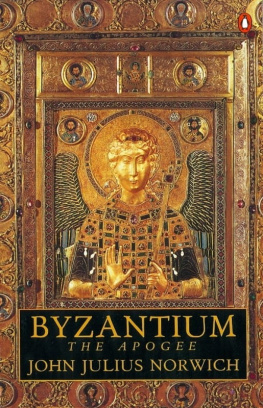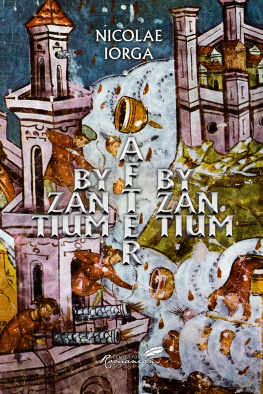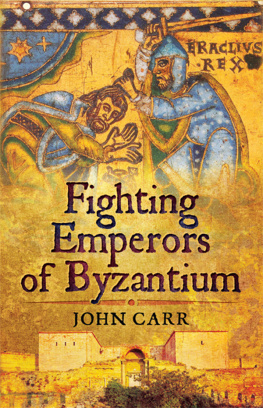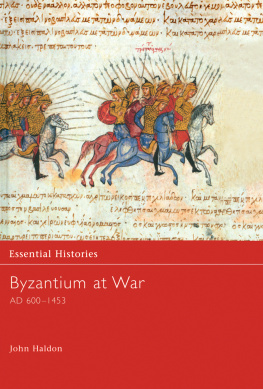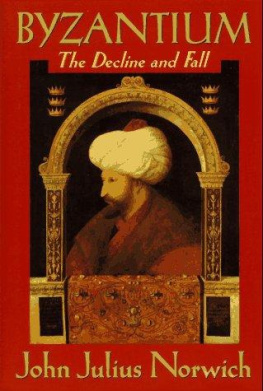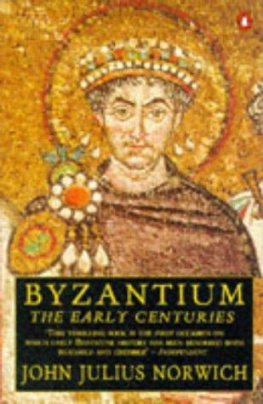John Julius Norwich - Byzantium: The Apogee (A History of Byzantium #2)
Here you can read online John Julius Norwich - Byzantium: The Apogee (A History of Byzantium #2) full text of the book (entire story) in english for free. Download pdf and epub, get meaning, cover and reviews about this ebook. year: 1993, publisher: Penguin, genre: Detective and thriller. Description of the work, (preface) as well as reviews are available. Best literature library LitArk.com created for fans of good reading and offers a wide selection of genres:
Romance novel
Science fiction
Adventure
Detective
Science
History
Home and family
Prose
Art
Politics
Computer
Non-fiction
Religion
Business
Children
Humor
Choose a favorite category and find really read worthwhile books. Enjoy immersion in the world of imagination, feel the emotions of the characters or learn something new for yourself, make an fascinating discovery.
- Book:Byzantium: The Apogee (A History of Byzantium #2)
- Author:
- Publisher:Penguin
- Genre:
- Year:1993
- Rating:4 / 5
- Favourites:Add to favourites
- Your mark:
- 80
- 1
- 2
- 3
- 4
- 5
Byzantium: The Apogee (A History of Byzantium #2): summary, description and annotation
We offer to read an annotation, description, summary or preface (depends on what the author of the book "Byzantium: The Apogee (A History of Byzantium #2)" wrote himself). If you haven't found the necessary information about the book — write in the comments, we will try to find it.
John Julius Norwich: author's other books
Who wrote Byzantium: The Apogee (A History of Byzantium #2)? Find out the surname, the name of the author of the book and a list of all author's works by series.
Byzantium: The Apogee (A History of Byzantium #2) — read online for free the complete book (whole text) full work
Below is the text of the book, divided by pages. System saving the place of the last page read, allows you to conveniently read the book "Byzantium: The Apogee (A History of Byzantium #2)" online for free, without having to search again every time where you left off. Put a bookmark, and you can go to the page where you finished reading at any time.
Font size:
Interval:
Bookmark:
BYZANTIUM: THE APOGEE
JOHN JULIUS NORWICH
PENGUIN BOOKS
Published by the Penguin Group
Penguin Books Ltd,.
First published by Viking 1991
Published in Penguin Books
19933579 108642
Copyright John Julius Norwich, 1991
All rights reserved.
Printed in England by
Clays Ltd, St Ives pic
Krum [800-14]
The Return of Iconoclasm [814-29]
Theophilus [829-42]
The Images Restored [842-56]
Of Patriarchs and Plots [8 5 7-66]
"Double Murder [866-7]
Basil the Macedonian [867-86]
Leo the Wise [886-912]
The Rise of Romanus [912-20]
The Gentle Usurper [920-48]
The Scholar Emperor [945-63]
The White Death of the Saracens [963-9]
John Tzimisces [969-76]
The Young Basil [976-89]
The Bulgar-Slayer [9891025]
The Decline Begins [1025-41]
The End of the Paphlagonians [1041-2]
Constantine Monomachus and the Schism [1042-5 5]
Prelude to Catastrophe [1055-9]
20. Manzikert [1059-81]
List of Emperors
List of Muslim Sultans
List of Patriarchs
List of Popes
Bibliography
Index
There is little to be said by way of introduction to this book, whose purpose is simply to continue the story which I began three years ago with its predecessor. In Byzantium: The Early Centuries I tried first to set the scene for Constantine the Great's tremendous decision to establish a new capital for the Roman Empire on the banks of the Bosphorus, and then to trace the fortunes of Constantine and his successors up to that memorable Christmas Day of ad 800 when Pope Leo III invested Charlemagne with the imperial crown and the title of Emperor of the Romans, thusin effect if not in theorycalling into question the supposed unity of Christendom and giving Europe two Emperors instead of one.
The present volume covers a shorter period than the first: rather less than three centuries as opposed to rather more than five. This is partly because, as always throughout history, there is an acceleration in the march of events: ever greater numbers of characters make their appearance on the scene and the whole canvas of the Eastern Mediterranean becomes, in consequence, increasingly crowded. The principal reason, however, lies in the fact that the contemporary authorities for this second period are a good deal more informative. For the first centuries of the Byzantine era the surviving records areas I pointed out in my earlier introductionquite pitifully thin, and, moreover, as likely as not to contradict each other. As to their entertainment value, only Procopius affords any real enjoymentalthough he, it must be said, makes up for a lot. Now, as the pace increases and the story builds up its own momentum, the chroniclers begin to proliferate and to enliven their accounts more and more frequently with portraits, descriptions and anecdotes. There are still isolated periodsthe early eleventh century is a case in pointfor which our sources are infuriatingly inadequate; but such periods are henceforth the exception rather than the rule. For the rest, thanks to such writers as Liudprand of Cremona, St Theophanes and his continuators, George Cedrenus, John Scylitzes and above all the odious but ever-fascinating Michael Psellus, we can enjoy an incomparably more colourful picture of life in the Imperial Palace of Byzantium in the early middle ages than we can of any other court in Europe. I have seized upon these writers with gratitude, and have quoted them, both directly and indirectly, with liberalsome may think too liberalabandon; and if this has resulted in a reduction of the time spanned by the pages that follow, I can only say that it has seemed to me a price worth paying.
It has enabled me, too, to end this second volume, as I ended the first, with one of the most important events in all Byzantine history. But whereas the accession of Charlemagne, traumatic as it was, proved a good deal less prejudicial to the Empire of the East than was generally believed at the time, the battle of Manzikert was an unmitigated catastrophe, the full significance of which was revealed with the gradual realization that the Empire had effectively lost, in the space of a few nightmare hours, three-quarters of Asia Minorthe territory on which it most relied and the most valuable that it possessed. And that loss, as it turned out, was only the beginning: once the Turks had overrun part of the Anatolian heartland it would be only a question of time before they occupied it all. The Balkan peninsula would follow; and then, finally, Constantinople itself. The Oriental conquerors were not inclined to hurry; the whole process would take them the best part of four centuries. But there can be no question that the advance that ended on Tuesday, 29 May 1453, when Sultan Mehmet II touched his turban to the floor of St Sophia in prayer and thanksgiving, had its origin on the distant field of Manzikert, 382 years before.
In the decade immediately following that most shattering and shameful defeat, while more and more of Asia Minor was engulfed in the Seljuk tide and the governments of Michael VII and Nicephorus III watched in helpless paralysis while the Empire descended further and further into anarchy, few intelligent Byzantines could have doubted that its days were numbered. But then, as happens so often in Byzantine historyfor was not Constantinople known to enjoy divine protection?came last-minute salvation. After a dozen near-grotesque occupants of the throne in little more than half a century, the figure of Alexius Comnenus takes on positively heroic proportions. The present book, of which the last page records his coronation on Easter Sunday 1081, thus ends on a note of hope; the story of how that hope was realized, however, must await the third volumewhich will, I trust, bring the long story to a close.
It remains only for me to add my usual caveat that although I have done everything I can do to make it as accurate as the existing sources permit, this book, like its predecessor, makes no claim to academic rigour. I knew little about Byzantium when I began writing about it, and shall doubtless have forgotten a good deal of what I have written soon after I come to the close. If I tend to give economic considerations less than their due, this is because I am not an economist and a three-volume work is quite long enough already. Similarly, if I concentrate on the personalities of Emperors and Empresses rather than on sociological developments, I can only plead that I prefer people to trends. Similarly, I have made no great efforts at consistency where the spelling of proper names is concerned. I have usually preferred the Latin version of the name, merely because it will probably be more familiar to English readers. On the other hand, where the Greek has seemed more suitable I have not hesitated to use it.
Those who wish* to sink their teeth into something more challenging need look no further than the Bibliography, where they will find the titles of many books of formidable scholarship; this one is not for them. From the outset my only object has been to provide the interested non-specialist with the sort of bird's-eye view of Byzantine history that I myself wanted when I first fell under the spell of the Eastern Mediterranean. The measure of my success must remain an open question: even in this relatively modest undertaking there is still the best part of four centuries to go. But we have now comfortably passed the point of no return; I, at least, am enjoying myself; and if I can persuade other kindred spirits to share my enjoyment I shall be happy indeed.
John Julius Norwich
London, Christmas 1990
Krum
[800-14]
Even were we birds, we could not hope to escape.
The Emperor Nicephorus I, just before his death
Next pageFont size:
Interval:
Bookmark:
Similar books «Byzantium: The Apogee (A History of Byzantium #2)»
Look at similar books to Byzantium: The Apogee (A History of Byzantium #2). We have selected literature similar in name and meaning in the hope of providing readers with more options to find new, interesting, not yet read works.
Discussion, reviews of the book Byzantium: The Apogee (A History of Byzantium #2) and just readers' own opinions. Leave your comments, write what you think about the work, its meaning or the main characters. Specify what exactly you liked and what you didn't like, and why you think so.

